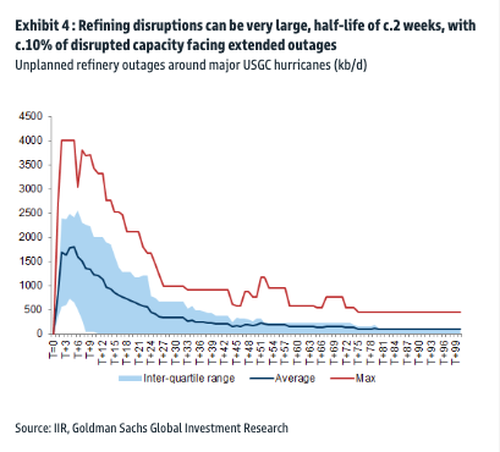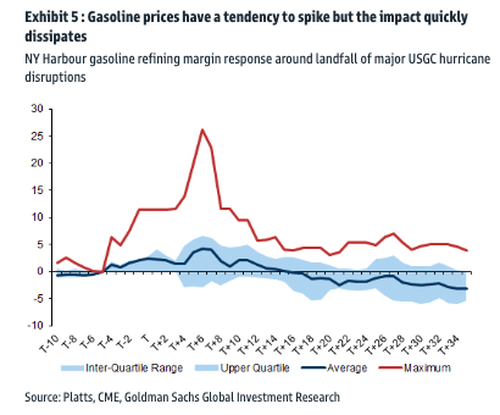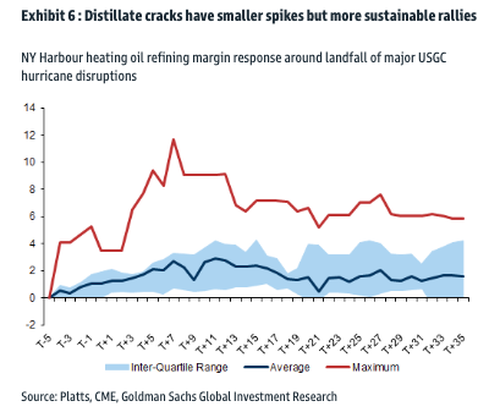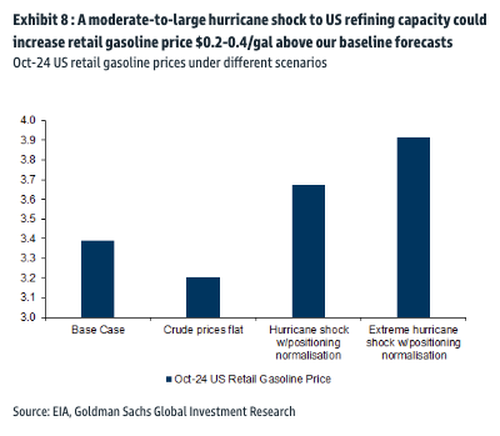La Nina Will Complicate Things For Biden Ahead Of Elections As Hurricanes Threaten Oil Refineries
The Biden administration must now contend with the La Nina weather phenomenon, which is expected to fuel an active Atlantic hurricane season. These storms could potentially disrupt major US Gulf Coast refineries, driving average gasoline prices at the pump to the politically sensitive $4 a gallon mark ahead of the November presidential elections.
News last month of the Department of Energy planning to release a million barrels of gasoline from reserves held in the Northeast ahead of the Fourth of July holiday and summer driving season shows just how concerned Democrats in the White House are about elevated inflation as their election odds falter.
According to the National Oceanic and Atmospheric Administration, La Nina conditions indicate reduced wind shear in the Alantic Basin, which promotes more tropical development in the Caribbean Sea.
"The upcoming Atlantic hurricane season is expected to have above-normal activity due to a confluence of factors, including near-record warm ocean temperatures in the Atlantic Ocean, development of La Nina conditions in the Pacific, reduced Atlantic trade winds and less wind shear, all of which tend to favor tropical storm formation," NOAA wrote in a recent update.
Here's a breakdown of NOAA's hurricane season forecast:
NOAA predicts an 85% chance of an above-normal 2024 Atlantic hurricane season.
There's a 10% chance of a near-normal season.
There's a 5% chance of a below-normal season.
The forecast includes 17 to 25 total named storms (winds of 39 mph or higher).
8 to 13 of these storms are expected to become hurricanes (winds of 74 mph or higher).
4 to 7 of the hurricanes may become major hurricanes (category 3, 4, or 5; winds of 111 mph or higher).
Forecasters have 70% confidence in this range
Given the context that La Nina is set to produce a more active hurricane season, Goldman analysts are now focusing on the potential refinery impacts of these storms and what this could potentially mean for gasoline prices at the pump.
Goldman's Callum Bruce's base case is that gasoline pump prices average around $3.3/gallon through October.
Bruce estimates pump prices in October could jump to the politically sensitive level of nearly $4 if the hurricane season is super active. If the season is calm, prices drop to $3.2.
Here's more from the report:
This fall's hurricane season, focused around August-October, but spilling modestly into July and November, may therefore be unusually important for the upcoming US Presidential election.
The National Oceanic and Atmospheric Administration (NOAA) predicts an above-normal Atlantic hurricane season, issuing a record high forecast for storms, hurricanes, and major hurricanes in its May outlook. The midpoint of its stated forecast ranges for each category is 100-200% of their historical averages (Exhibit 3).
Hurricanes have the potential to cause significant disruptions to US Gulf Coast refining capacity, where c.50% of US capacity lies. Most hurricanes that hit the refining centers on the Gulf Coast will take out 0.5-2.5 mb/d of refining capacity temporarily. Hurricane disruptions in the top quartile of events will take out more than 1mb/d of capacity for over a month. While these impacts are mostly temporary, large disruptions can leave c.10% of the peak disrupted capacity offline for a more extended period of time (Exhibit 4).
Wholesale gasoline refining margins have the potential to spike around these events (Exhibit 5), by $5/bbl or more, depending on the exact path of the hurricanes. Gasoline prices tend to be most volatile as – unlike distillate – the US is a net importer, and resupply is much further away.
The price impact tends to dissipate relatively quickly, however, as refining capacity returns relatively rapidly. In addition, there can be significant negative impacts on demand from the poor weather and flooding. We find that large USGC hurricanes disrupt 100 kb/d of demand on average in the affected months, and closer to 300 kb/d for the largest. Evacuations provide only a modest offsetting boost (<25 kb/d).
Diesel margins meanwhile benefit more sustainably as demand is only modestly impacted (<50 kb/d) as reconstruction and rescue efforts support consumption (Exhibit 6).
Nevertheless, retail gasoline prices can remain supported for longer as retailers are slow to lower prices after the initial spike, allowing marketing margins to expand. Despite normalized wholesale gasoline margins within a month, the top quartile of hurricane disruptions saw retail gasoline margins $0.20/gal higher over the following couple of months. The largest hurricanes have the capacity to raise these retail prices by almost $0.50/gal at their peak over this time period (Exhibit 7).
This may be amplified by a normalisation in current very low speculative positioning in refined products – 10th-20th percentile across refined products. Our prior research has found a c.$5/bbl impact on wholesale refined product margins simply from positioning normalisation, equating to around c.$0.10/gal at the retail level.
A significant hurricane disruption combined with a normalisation in positioning could therefore lift Oct-24 retail gasoline prices by $0.2-0.5/gal above our baseline forecasts over the full month (Exhibit 8). An extreme disruption would therefore take US retail gasoline prices to $4/gal, potentially leading to a spike in media coverage. However, retail prices would drop to $3.2/gal if crude prices are flat and disruptions are avoided.
Queue up more SPR gasoline dumps if the active hurricane season takes out a refinery or two, as the administration will do everything in its power to prevent pump prices from hitting $4 before the elections.
So who wins?
Biden arrives at Omaha Beach in his perpetual state of confusion pic.twitter.com/FKgllybpyN
— RNC Research (@RNCResearch) June 6, 2024
Mother Nature or elderly Biden?









